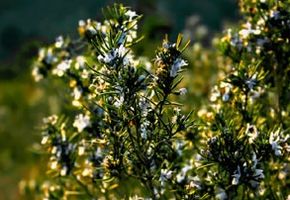Rosemary is a shrub that comes in all sizes; not only is it rooted easily, it is also grown from seed and sold while small. The somewhat pine-scented leaves are flat but needle-shaped. Lightly touching the leaves releases the scent. The stems are woody, and small blue or, rarely, white flowers appear along the stems. Rosemary may be upright or prostrate and, where it is hardy, grows as high as six or seven feet. More often, it is grown in pots and kept to smaller sizes. It takes well to pruning and is sometimes seen in cone-shaped or ball-shaped topiaries.
How to grow: Plant rosemary in containers or in the garden, in any light, well-drained soil of average fertility. Prune for shape, and protect from wind and bitter cold below 10 degrees Fahrenheit.
Advertisement
Uses: Best known as a culinary plant, rosemary leaves are used to season lamb, fish, soup, and other foods. In the garden, it makes a good shrub or hedge where it is hardy. The prostrate form can be used as a ground cover. Rosemary is elegant and easy in containers.
Scientific name: Rosmarinus officinalis
Advertisement
